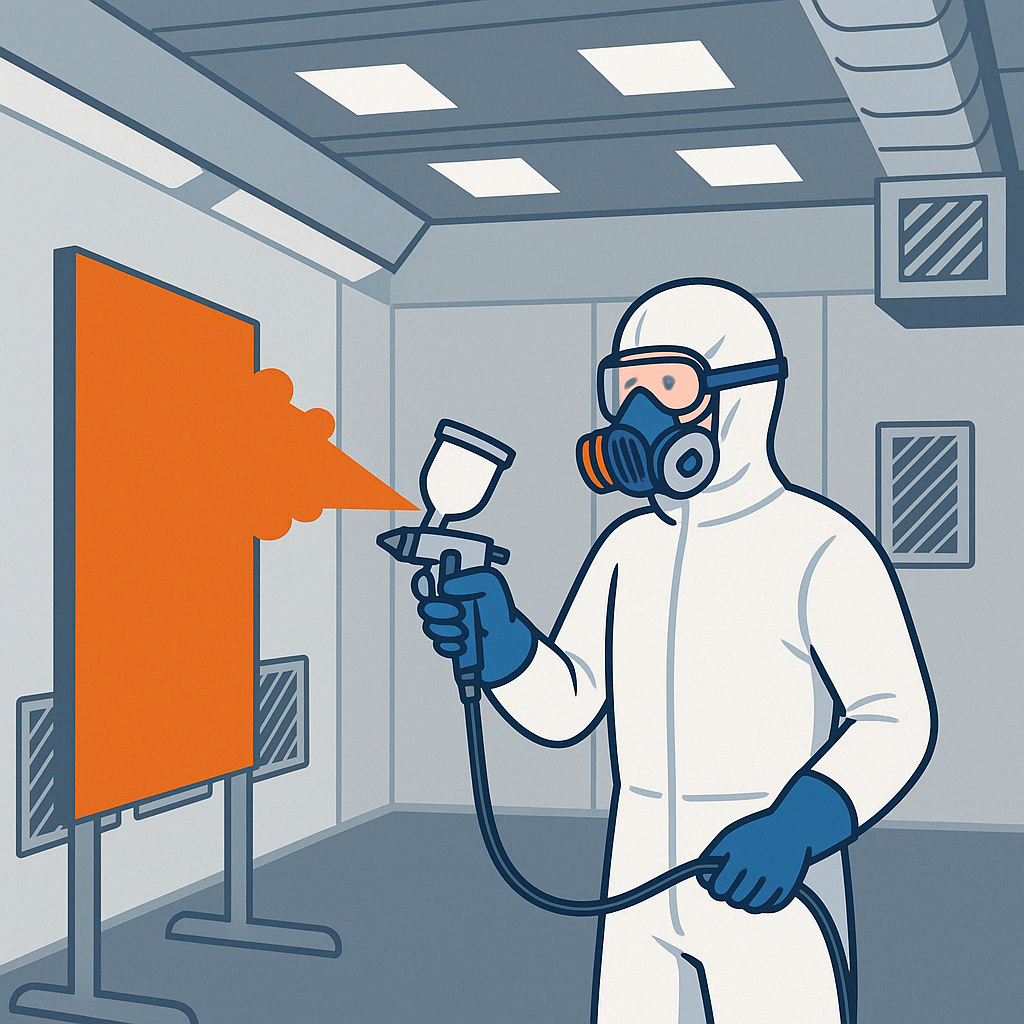Paint Booth Safety is a vital part of any painting operation involving enclosed spray areas.
From automotive body shops to industrial coating facilities, improperly managed paint booths pose severe risks—including toxic exposure, fire hazards, and environmental contamination.

By implementing proper ventilation and fire prevention protocols, employers can protect workers and comply with regulatory standards while ensuring high-quality finishes.
- Why Paint Booth Safety Matters
- Understanding Paint Booth Types and Their Hazards
- Best Practices for Paint Booth Ventilation
- Fire Prevention Strategies for Paint Booths
- PPE Requirements Inside Paint Booths
- Training and Regulatory Compliance
- Internal Inspections and Continuous Monitoring
- Conclusion: Paint Booth Safety Saves Lives and Livelihoods
Why Paint Booth Safety Matters
Paint booths concentrate flammable vapors and hazardous airborne particles in a confined space.
According to the Canadian Centre for Occupational Health and Safety (CCOHS), the accumulation of these materials—if not properly managed—can result in explosions, flash fires, and long-term health issues due to inhalation of volatile organic compounds (VOCs).

Well-maintained and compliant spray booths reduce the risk of:
- Fire and explosion
- Respiratory exposure to VOCs and solvents
- Poor coating application due to contamination or airflow imbalance
- Environmental violations for emissions and hazardous waste
Understanding Paint Booth Types and Their Hazards
There are several types of spray booths commonly used in various industries:
- Downdraft Booths – Ventilate air vertically from the ceiling down through the floor.
- Crossdraft Booths – Air moves horizontally from the front to rear.
- Semi-downdraft Booths – A hybrid system with improved airflow control.
- Open-face Booths – Used for limited applications with lower containment requirements.
Each booth type comes with specific airflow design and fire safety needs, and must be maintained as per NFPA 33 (Standard for Spray Application Using Flammable or Combustible Materials).
Best Practices for Paint Booth Ventilation

1. Maintain Proper Airflow Rates
A paint booth must maintain continuous airflow during all spray operations. Typical ventilation requirements include:
- Downdraft systems: ≥100 ft/min face velocity
- Crossdraft systems: ≥150 ft/min airflow across the work surface
Air movement must be uniform and prevent dead zones where vapors can accumulate.
2. Use Explosion-Proof Ventilation Equipment
Fans, motors, and lights inside the booth must be explosion-proof and CSA-approved for use in hazardous locations. This prevents ignition from electrical sparks in vapor-rich environments.
3. Regular Filter Maintenance
Intake and exhaust filters trap contaminants and prevent overspray from escaping. Replace them regularly based on use and follow manufacturer instructions.
Clogged filters can reduce airflow, cause pressure imbalances, and increase fire risks.
4. Monitor Air Quality and VOC Levels
Install continuous air quality sensors and VOC monitors to ensure levels remain below occupational exposure limits (e.g., from WorkSafeBC or ACGIH standards).
Alarm systems should be integrated for real-time alerts when levels exceed safe thresholds.
Fire Prevention Strategies for Paint Booths
1. Control Flammable Vapors
Only use paints and solvents that comply with safety regulations.
Store flammable materials in approved fire-resistant cabinets, and dispense them in well-ventilated areas using grounded metal containers to prevent static discharge.
2. Install Fire Suppression Systems
According to NFPA 33, all spray booths must be equipped with automatic fire suppression systems, such as:
- Dry chemical systems
- Water sprinklers
- CO₂ suppression units
Test these systems regularly and conduct fire drills to ensure worker preparedness.

3. Eliminate Ignition Sources
Strictly prohibit smoking, open flames, or unapproved electrical devices near spray areas. Tools used inside booths should be non-sparking and designated for flammable atmospheres.
4. Implement Static Electricity Controls
Ground all metal components, spray equipment, and containers to prevent static electricity buildup. Use antistatic mats and grounding wrist straps when necessary.
PPE Requirements Inside Paint Booths
Even with engineering controls in place, painters must wear proper personal protective equipment (PPE), including:
- Respirators with organic vapor cartridges or supplied-air respirators
- Chemical-resistant gloves and coveralls
- Eye protection (goggles or full-face shields)
- Anti-static footwear
Refer to CSA Standard Z94.4 for respirator selection and fit testing protocols.
Training and Regulatory Compliance
Paint booth operators must receive training on:
- Booth startup/shutdown procedures
- Emergency response and evacuation
- Safe chemical handling and storage
- Equipment cleaning and maintenance
Compliance with WHMIS 2015, local fire codes, Occupational Health and Safety Regulations, and environmental emission standards is non-negotiable. Documentation should be available for all inspections, SDS sheets, and fire suppression certifications.
For ongoing support and OHSE training resources, visit OHSE.ca, a Canadian leader in workplace safety.
Internal Inspections and Continuous Monitoring
Schedule weekly and monthly inspections of ventilation systems, filters, lighting, and fire protection equipment. Airflow meters and manometers can help detect reduced performance before it becomes a hazard.

Checklist items should include:
- Filter status and cleanliness
- Vent fan operation
- Lighting and electrical condition
- Overspray buildup inside booths
- Fire suppression system pressure and status
Use these audits as part of your company’s continuous improvement and safety management system.
Conclusion: Paint Booth Safety Saves Lives and Livelihoods
Maintaining paint booth safety is not just about compliance—it’s about protecting workers from serious injuries, reducing environmental impact, and preserving equipment investments.
By focusing on ventilation, fire prevention, PPE, and worker training, you can ensure a safe and productive painting environment for everyone involved.

No comments yet